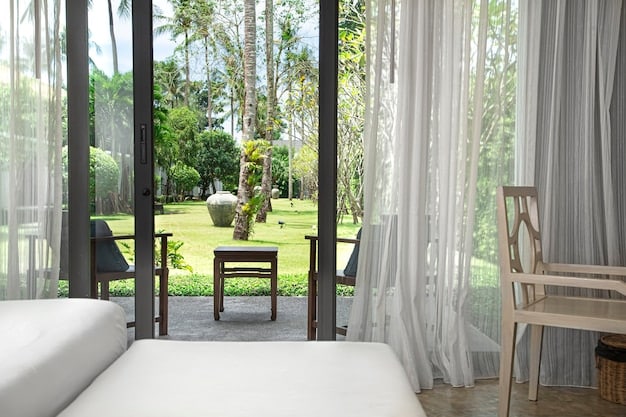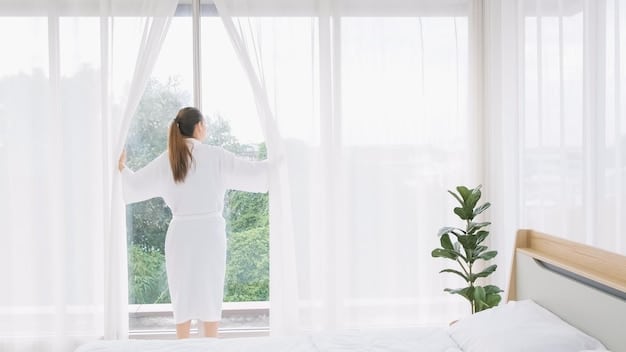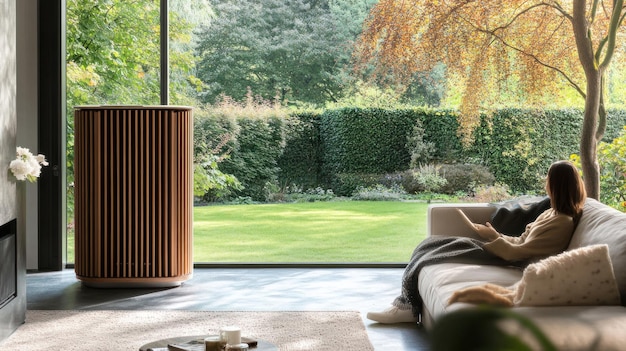Maximize Natural Light: 5 Interior Design Strategies for 2025

Maximizing natural light in your home involves strategic interior design choices that optimize light reflection, minimize obstructions, and enhance the overall brightness and appeal of your living spaces for 2025.
Wondering how to transform your home into a haven of natural light? Discover the top 5 interior design strategies for 2025 to maximize natural light in your home and create a brighter, more inviting space.
How to Maximize Natural Light in Your Home: 5 Interior Design Strategies for 2025
Natural light is a powerful element in interior design, capable of transforming a dull and dreary home into a vibrant and welcoming space. As we look ahead to 2025, innovative design strategies are emerging to harness and amplify natural light, creating homes that are not only visually appealing but also promote well-being. Let’s explore five effective interior design strategies that will help you make the most of natural light in your home.
1. Optimize Window Placement and Size
The foundation of maximizing natural light lies in the strategic placement and size of your windows. Proper planning can significantly impact the amount of sunlight that enters your home, influencing the overall brightness and ambiance. Consider the orientation of your home and identify areas where larger or additional windows could be installed to capture more light.
Assess Sunlight Exposure
Understanding how sunlight interacts with your home throughout the day is crucial. South-facing windows generally receive the most sunlight, making them ideal for living areas and rooms where you want to maximize warmth and brightness. East-facing windows capture the morning sun, perfect for bedrooms and kitchens, while west-facing windows receive the afternoon sun, which can be intense during the summer months. North-facing windows provide soft, diffused light, suitable for studios or reading nooks.
Window Size Matters
Larger windows allow more sunlight to enter, but it’s not just about size. The proportion of window area to wall area is also important. Aim for a balance that provides ample light without compromising privacy or energy efficiency. Consider floor-to-ceiling windows or picture windows in spaces where you want to make a dramatic statement and flood the room with natural light.
- Strategic Placement: Position windows to capture the best sunlight exposure based on room function.
- Maximize Size: Opt for larger windows or additional windows to increase light flow.
- Balance: Maintain a balance between window area, wall space, and energy efficiency.
- Consider Skylights: Install skylights to bring light into areas where vertical windows are not feasible.
Optimizing window placement and size is a fundamental step in maximizing natural light. By carefully considering sunlight exposure, window dimensions, and architectural integration, you can create a home that is bathed in natural light, enhancing its beauty and functionality.
2. Choose Light and Reflective Colors
Color plays a significant role in how light is reflected and distributed within a space. Light and reflective colors can amplify natural light, making rooms feel brighter and more spacious. Selecting the right color palette is essential for maximizing the impact of natural light in your home.
White and Off-White Tones
White is the ultimate light reflector, bouncing light around the room and creating a sense of openness. Off-white tones, such as cream, ivory, and alabaster, offer a similar effect while adding a touch of warmth. These colors are versatile and can be used on walls, ceilings, and furniture to enhance natural light.
Pale and Pastel Shades
Pale and pastel shades, such as light blues, greens, and yellows, also have reflective properties. These colors create a soft and airy atmosphere, making rooms feel more inviting and cheerful. They work well in bedrooms, bathrooms, and other spaces where you want to create a relaxing ambiance.

Reflective Finishes
Consider using paints with a glossy or semi-gloss finish to maximize light reflection. These finishes have a smoother surface that bounces light more effectively than matte finishes. However, be mindful of the glare that glossy finishes can create in areas with direct sunlight. A satin or eggshell finish is a good compromise, offering a balance between reflectivity and comfort.
Choosing light and reflective colors is a simple yet effective way to boost natural light in your home. By selecting the right color palette and finishes, you can amplify the impact of sunlight, creating interiors that are bright, spacious, and visually appealing.
3. Incorporate Mirrors and Reflective Surfaces
Mirrors and reflective surfaces are powerful tools for amplifying natural light and creating the illusion of space. Strategically placed mirrors can bounce light around the room, brightening dark corners and enhancing the overall sense of openness. Incorporating reflective materials can also add visual interest and sophistication to your interior design.
Strategic Mirror Placement
Position mirrors opposite windows to maximize the reflection of natural light. A large mirror placed on a wall perpendicular to a window can capture and redirect sunlight, illuminating the entire room. Consider using multiple smaller mirrors to create a more diffused and layered effect.
Reflective Materials
Incorporate reflective materials such as glass, metal, and polished stone to bounce light around the room. Glass-topped tables, metal light fixtures, and polished floors can add subtle shimmer and enhance the overall brightness. Consider using mirrored furniture or accessories to create a focal point and amplify the impact of natural light.
- Opposite Windows: Place mirrors opposite windows to reflect natural light.
- Strategic Angles: Position mirrors at angles to capture and redirect sunlight.
- Multiple Mirrors: Use multiple smaller mirrors to create a layered effect.
- Reflective Accessories: Incorporate glass, metal, and polished stone to add shimmer.
Incorporating mirrors and reflective surfaces is an excellent way to enhance natural light and create a more dynamic and visually appealing space. By strategically placing mirrors and incorporating reflective materials, you can transform your home into a bright and inviting haven.
4. Minimize Obstructions and Maximize Open Spaces
Obstructions can block or reduce the amount of natural light that enters your home. Minimizing these obstacles and maximizing open spaces allows light to flow freely, creating a brighter and more spacious environment. Streamlining your interior design is key to optimizing natural light.
Declutter and Organize
Clutter can absorb light and make a room feel smaller and darker. Regularly declutter your space to remove unnecessary items that block light or create visual distractions. Organize your belongings in storage solutions that keep clutter out of sight, such as shelves, cabinets, and baskets.
Choose Transparent or Lightweight Furniture
Opt for furniture with transparent or lightweight designs to minimize obstructions and allow light to pass through. Glass-topped tables, acrylic chairs, and open shelving units can create a sense of openness and airiness. Avoid bulky or heavy furniture that blocks light and makes a room feel cramped.

Optimize Layout
Arrange your furniture to maximize the flow of natural light. Avoid placing tall or bulky items in front of windows, as they can block light and create shadows. Position your seating areas and workspaces to take advantage of the available sunlight. Consider using room dividers or screens to create functional zones without obstructing the flow of light.
Minimizing obstructions and maximizing open spaces is essential for optimizing natural light in your home. By decluttering, choosing lightweight furniture, and optimizing the layout, you can create a brighter, more spacious, and more inviting environment.
5. Use Lightweight Window Treatments
Window treatments play a crucial role in controlling the amount of natural light that enters your home. Heavy or opaque window coverings can block light, while lightweight and translucent options allow light to filter through, creating a soft and diffused glow. Selecting the right window treatments can significantly impact the brightness and ambiance of your space.
Sheer Curtains and Drapes
Sheer curtains and drapes are an excellent choice for maximizing natural light while maintaining privacy. These lightweight fabrics allow sunlight to filter through, creating a soft and airy atmosphere. They come in a variety of colors and textures, allowing you to customize your window treatments to match your interior design.
Light-Filtering Shades and Blinds
Light-filtering shades and blinds offer a balance between privacy and light control. These window coverings allow a certain amount of light to pass through while providing a barrier against prying eyes. Consider cellular shades, roller shades, or Venetian blinds with adjustable slats to control the amount of light that enters your home.
- Sheer Fabrics: Opt for sheer curtains or drapes to maximize light flow.
- Light-Filtering Shades: Use light-filtering shades or blinds for privacy and light control.
- Adjustable Options: Choose window treatments with adjustable slats or panels.
- Avoid Heavy Fabrics: Steer clear of heavy or opaque window coverings.
Using lightweight window treatments is a simple and effective way to enhance natural light in your home. By selecting sheer fabrics, light-filtering shades, and adjustable options, you can control the amount of light that enters your space, creating a bright, comfortable, and inviting environment.
| Key Point | Brief Description |
|---|---|
| ☀️ Window Optimization | Strategic window placement and size for maximum sunlight. |
| 🎨 Light Colors | Using white and pale colors to reflect light. |
| 🪞 Mirrors | Strategic mirror placement to amplify natural light. |
| 🛋️ Open Spaces | Maximizing open space and minimizing clutter for light flow. |
FAQ
▼
South-facing windows are generally the best for maximizing natural light as they receive the most sunlight throughout the day. East-facing windows capture morning light, while west-facing windows get afternoon sun.
▼
Light colors, especially white and off-white, reflect more light than dark colors. This helps to bounce sunlight around the room, making the space feel brighter and more open.
▼
Mirrors should be placed opposite windows to reflect the incoming light back into the room. Positioning them on walls perpendicular to windows can also help to spread light more evenly.
▼
Lightweight and translucent window treatments like sheer curtains or light-filtering shades are ideal. These allow light to enter the room while providing some level of privacy or sun control.
▼
Decluttering removes obstacles that can block or absorb light. By having fewer items in the room, natural light can flow more freely, enhancing the overall brightness and spaciousness of the area.
Conclusion
By implementing these five interior design strategies, you can significantly enhance the natural light in your home, creating a brighter, more inviting, and energy-efficient living space. As we move towards 2025, these techniques will continue to be essential for homeowners looking to maximize the beauty and functionality of their homes.





